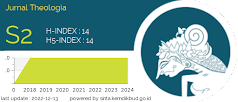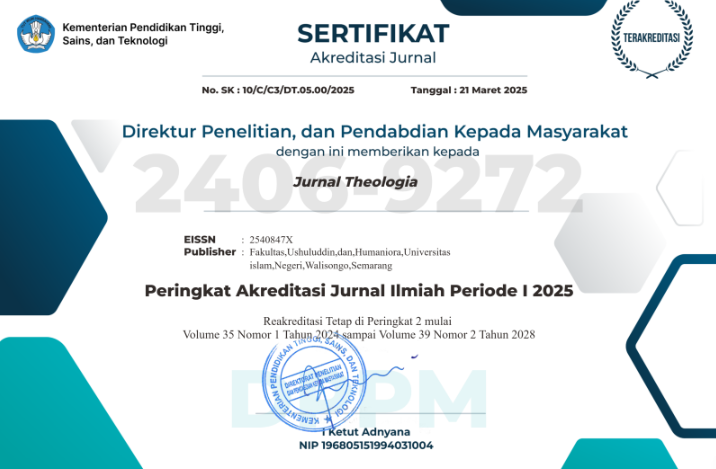MEKANISME PENYELESAIAN AYAT KONTRADIKTIF BERBASIS MAQĀṢID AL-SHARĪ’AH: Studi terhadap Ayat Perkawinan Beda Agama
DOI:
https://doi.org/10.21580/teo.2017.28.1.1413Keywords:
ayat kontradiksi, maqāṣid al-sharī’ah, perkawinan beda agama, tarjih, pendekatan sistemAbstract
Abstract: The paper demonstrated approaches of maqāṣid al-sharī’ah in understanding contradictory verses. Methods available during this time, have been reflecting the firm dominance of languages in describing those verses. In sequence, the completion mechanisms of contradictory verses known are: 1) al-jam’ wa al-taufīq (combining and compromising the verses); 2) al-tarjīḥ (strengthening one of the verses); 3) an-naskh (amending the stipulation in one of the verses); and 4) al-tasāquṭ (restoring the stipulation in the general rule). The reading with linguistics-based, frequently makes the verse apart from its context. In contrast to the completion of this study, the reading of maqasid ash-shari’ah based on system approach as the method of analysis. The Quran is positioned as a system that has six features, namely the nature of cognition, holistic, inclusive, interconnect hierarchy, multidimensional, and purposiveness. These features will be applied to describe the contradictions of the verses. To be operational, it is arranged into four steps: 1) identifications of verses; 2) identifications of meanings; 3) explorations of maqāṣid al-sharī’ah; and 4) conclusion. The author found that this method can provide an applicative and unambiguous conclusion because it is consistent with the maqasid ash-shari’ah. The author takes the example verses of interfaith marriage. The Quran explicitly mentioned the stipulations of interfaith marriage in three verses. Two verses of them allow while the other verses forbid. In literbike, these verses seem contradictory.
Abstrak: Tulisan ini akan mendemonstrasikan pendekatan maqāṣid al-sharī’ah dalam memahami ayat-ayat kontradiktif. Metode yang tersedia selama ini, mencerminkan kokohnya dominasi kebahasaan dalam menguraikan ayat-ayat tersebut. Secara berurutan, mekanisme penyelesaian ayat kontradiktif yang dikenal adalah: 1) al-jam’ wa al-taufīq (menggabungkan dan mengkompromikan ayat); 2) at-tarjīḥ (menguatkan salah satu ayat); 3) al-naskh (mengamandemen ketentuan salah satu ayat); dan 4) at-tasāquṭ (mengembalikan ketentuan pada kaidah umum). Pembacaan tersebut, tidak jarang menjadikan ayat terlepas dari konteksnya. Ini berbeda dengan model penyelesaian yang ditawarkan dalam penelitian ini, yakni pembacaan berbasis maqasid asy-syari’ah dengan pendekatan sistem (system aproach) sebagai metode analisisnya. al-Qur’an diposisikan sebagai sebuah sistem yang memiliki enam fitur, yaitu sifat kognisi, holistik, inklusif, interkoneksi hierarki, multidimensi, dan kebermaksudan. Fitur- fitur tersebut akan diterapkan untuk menguraikan kontradiksi ayat. Adapun operasioanlisasinya tersusun menjadi empat langkah, yaitu: 1) identifikasi ayat; 2) identifikasi makna; 3) eksplorasi maqāṣid al-sharī’ah; dan 4) penarikan kesimpulan. Penulis mendapati bahwa metode ini dapat memberikan kesimpulan yang aplikatif dan tidak ambigu, karena sejurus dengan tujuan syariat. Penulis mengambil contoh ayat tentang perkawinan beda agama. al-Qur’an secara eksplisit menyebutkan ketentuan perkawinan beda agama dalam tiga ayat. Dua ayat diantaranya membolehkan, sedangkan satu ayat lainnya melarang. Secara tekstual, ayat-ayat tersebut nampak bertentangan.
Downloads
References
Ali, Maulana Muhammad, The Holy Qur’an: Arabic Text, English Translation, and Commentary,. Lahore: Ahmadiyyah Anjuman Isha’at Islam, 1973.
Anas, Mohammad, “Metode Memahami Hadis-hadis Kontradiktif,” Jurnal Muta¬watir, Vol. 3, No . 1, UIN Sunan Ampel, Surabaya, 2013.
‘Āshūr, al-Ṭāhir Ibn, Maqāṣid asy-Syarī’ah al-Islāmiyyah. ‘Ammān: Dār al-Nafā’is, 2001.
Atabik, Ahmad, “Kontradiksi antar Dalil dan Cara Penyelesaiannya Prespektif Ushuliyyin,” Jurnal Yudisia, Vol. 6, No . 2., STAIN Kudus, 2015.
Auda, Jasser, Maqāṣid al-Sharī’ah as Philosophy of Islamic Law: A System Aproach. London: IIIT, 2007.
Baidhawy, Zakiyuddin, “Piagam Madinah dan Pancasila: Prinsip-prinsip Ke¬hidup¬an Bersama dalam Berbangsa dan Bernegara,” dalam Wawan Gunawan Abd. Wahid dkk, Fikih Kebinekaan: Pandangan Islam Indonesia tentang Umat, Kewarganegaraan, dan Kepimpnan Non-Muslim. Bandung: Mizan Pustaka, 2015.
Darwazah, Muḥammad ‘Izzah, a’-Tafsīr al-Ḥadīth Tartīb al-Suwār Ḥasab an-Nuzūl, Vol. VI, Beirut: Dār al-Garb al-Islāmī, 2000.
Departemen Agama RI, al-Qur’an dan Terjemahnya., t.t.p..: Sygma Examedia, t.th.
al-Dimasyqī, Abū al-Fidā’ Ismā’īl ibn Kathīr, Tafsīr al-Qur’ān al-‘Aẓīm, Vol. 15. Qāhirah, Mu’assasah Qurṭubah, 2000.
al-Fāsī, ‘Allāl, Maqāṣid asy-Syarī’ah al-Islāmiyyah wa Makārimuhā, Beirut: Dār al-Garb, 1993.
Haris, Abdul, “Nasikh dan Mansukh dalam al-Qur’an,” Jurnal Tajdid, Vol. 13, No. 1. IAIN Sultan Thaha Saifuddin, Jambi, 2014.
Izutsu, Toshihiko, Relasi Tuhan dan Manusia: Pendekatan Semantik terhadap al-Qur’an. Terj. Agus Hari Husein dkk. Yogyakarta: Tiara Wacana, 1997.
Lings, Martin, Muhammad: Kisah Hidup Nabi Berdasar Sumber Klasik. Terj. Qamaruddin S.F, Jakarta: Serambi Ilmu Semesta, 2014.
al-Mubarakfurī, Ṣafī al-Raḥmān, Sirah Nabawiyah: Sejarah Hidup Nabi Muhammad, terj. Agus Suwandi, Jakarta: Ummul Qura, 2015.
al-Qurṭubī, Abū ‘Abd Allāh Muḥammad bin Aḥmad bin Abī Bakr, al-Jāmi’ li Aḥkām al-Qur’ān, vol. III. Beirut: Mu’assasah ar-Risālah, 2006.
al-Raisūnī, Aḥmad, Fikr al-Maqāṣidī Qawā’iduhu wa Fawā’iduhu. Ribāt: Maṭba’ah al-Najāḥ, 1999.
Saeed, Abdullah, al-Qur’an Abad 21: Tafsir Kontekstual. Terj. Ervan Nurtawab. Bandung: Mizan Pustaka, 2015.
al-Ṣābūnī, Muḥammad ‘Alī, Ṣafwah al-Tafāsīr, Vol. III. Beirut: Dār al-Qur’ān al-Karīm, 1981.
Shihab, Quraish, Membaca Sirah Nabi Muhammad SAW dalam Sorotan al-Qur’an dan Hadis-hadis Sahīh. Tangerang: Lentera Hati, 2014.
Suhadi, Kawin Lintas Agama: Perspektif Kritik Nalar Islam. Yogyakarta: LKiS, 2006.
Tim Penyusun, Kamus Besar Bahasa Indonesia, Jakarta: Pusat Bahasa Departemen Pendidikan Nasional RI, 2008.
al-Zuḥailī, Wahbah, Uṣūl al-Fiqh al-Islāmī, Vol. I. Damaskus: Dār al-Fikr, 1986.





















